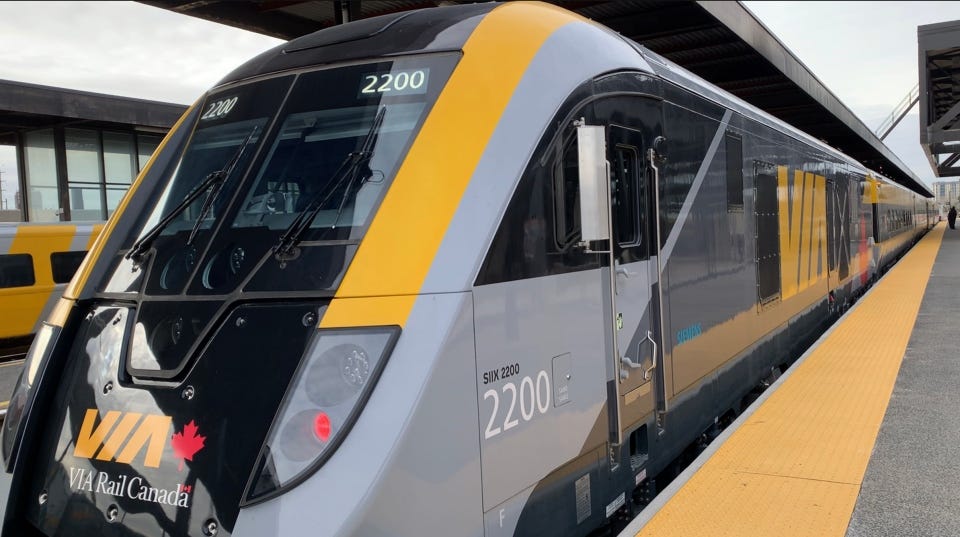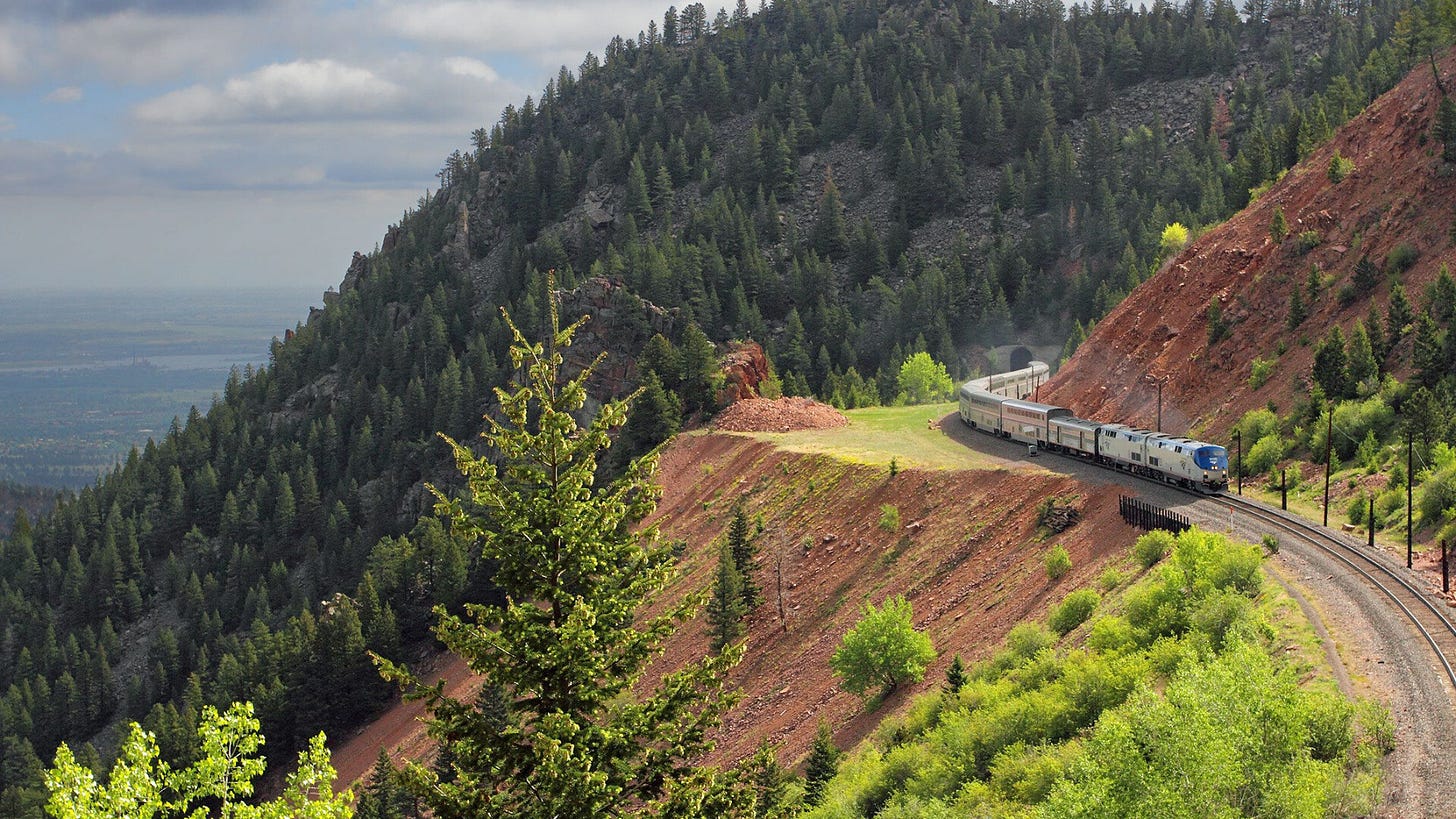Rail Fail
North America's passenger trains, once world-beaters, have become global laughing stocks.
It’s an old-guy cliché to profess a love for trains, and then go on about how much better things were in the good ol’ days. Whatever, grandpa—the age of steam is over, buy a Tesla already!
Well, I hope you’ll sit down a spell and indulge me, because, passenger-rail-wise, things really were better (and faster, and more frequent) in North America not so long ago. They could be that way again. Hell, given the fact that Joe “Amtrak” Biden is currently POTUS and a Conservative isn’t the PM of Canada, they should be that way again. Widespread inter-city passenger rail service, preferably electric and affordable, should be a no-brainer: one of the lowest-hanging fruits when it comes to wrangling the climate crisis and reducing emissions.
A century ago, the United States had 380,000 miles (610,000 kms) of tracks, more than any other nation. As early as 1934, Burlington’s streamlined Pioneer Zephyr crossed a thousand miles of the rural Midwest at an average speed of 78 mph (125 km/h), regularly topping out at 112 (180 km/h) in its non-stop run from Denver to Chicago. In the 1950s, the trip from Chicago to Minneapolis on the Olympian Hiawathan took only four and a half hours (today, on Amtrak’s Empire Builder, it takes more than eight). Fabulously appointed sleeper cars, and chefs that rivaled New York’s best, made trains like the Hollywood-bound Super Chief into international by-words for glamor.
The United States’s infinitely ramified rail network, whose veins and capillaries once reached into every small town in the nation, has shrunk to 100,000 miles (160,000 kms), the same level as in 1881. In 2022, Amtrak proudly announced a record ridership of 23 million—not a bad showing, unless you compare it to the ’twenties, when American trains were carrying 1.3 billion passengers a year.
And North American trains were world-beaters: in 1967, a jet-nosed gas-turbine locomotive called the TurboTrain broke the record for high-speed travel, reaching 171 mph (275 km/h) on a track in New Jersey. The TurboTrain, as operated by Canadian National, made the run from Toronto to Montreal in the 1970s in 3 hours and 59 minutes. The last time I took a Via Rail train to Toronto, it took over 5 hours—actually more, because we rolled into Union Station half an hour late, which is almost always the case. The last time I took Amtrak’s Adirondack from Montreal to New York (this used to be an overnight service, and should be again), it took all day and, once I’d accounted for delays at the border and random stops in farmers’ fields, averaged a beyond-pokey 30 mph (50 km/h).
When I travel in Italy, France, Germany, or Spain, I can rely on passenger trains to get me almost anywhere I want to go. In Europe, freight is transported by truck, and passengers by high-speed electric rail; in North America, it’s the opposite (often with tragic results, if you’ll recall the derailment that obliterated the center of Lac-Megantic, or the chemical spill that sent a mini-mushroom cloud rising in Ohio earlier this year). Recently, there’s been a renaissance in European sleeper trains, among them the NightJet from Zurich to Amsterdam, which allow you to save on a hotel room and wake up in a new city.

Some people argue that the geography of Europe makes it more suited to rail, while North America is more suited to plane travel. The first, obvious, response to that is that we had fast and comfortable rail service all through this continent up until the 1950s. The second is that vast swaths of this continent are quite densely populated, and would best be served by passenger rail. The population density of the American Midwest is similar to that of Spain. Yet Spain has 2,240 miles (3,600 kms) of high-speed rail, while the Midwest has, let’s see now…0 miles (0 kms).
One of the most obvious routes for high-speed rail line would be from Quebec City to Windsor (aka, for any Journey fans out there, south Detroit), by way of Toronto and Montreal. An astonishing 50 percent of Canada’s 39 million people live in this corridor. Yet Via Rail still runs slow, infrequent—and frequently late—diesel trains. They can also be expensive, typically $120 Canadian for a one-way trip between Toronto-Montreal, especially if you don’t reserve a couple of weeks in advance; contrast this with Barcelona-Madrid, almost the same distance, where you can get one-way tickets on high-speed Avlo trains for as little as €7.
In Canada, I’ve been hearing rumors of more frequent electric rail service for as long as I can remember. There does seem to be some signs that things are changing for the better. Recently new Siemens-made train sets hit the tracks (they’re still diesel, but can be converted to run on electricity).
The latest news is that Canada is mulling “High Frequency Rail” on the Windsor-Quebec City corridor.1 Not, you'll note, "High Speed." As usual, we Canadians will proceed with an abundance of caution, which means that the first train might be running just in time for the Year-Round-Wildfire-and-Atmospheric-River Catastrophe of 2052. Studying high-speed rail and then failing to actually build it has become such a joke that, a decade ago, it got spoofed on the Rick Mercer Report. ("Canada has long been a world-leader in high-speed rail study...")
The United States does have some high-speed rail: for example, the Acela, which makes the run from DC to NY in 2 hours and 45 minutes. Though its locomotives are capable of 200 mph (320 km/h), the Acela barely averages 88 mph (140 km/h) between those two cities. In Europe, the Acela would qualify as a regional express, not a true high-speed train. And it can be expensive: up to $200 for a one-way ticket. The Brightline train that has been operating from Miami to West Palm Beach is also an underachiever: billed as high-speed, it averages 80 mph (130 km/h).
Look, high-speed would be great. The way things are, though, I’d be satisfied with more frequent, pleasant, widespread (and, why not, dream big, affordable) rail service between cities in North America. I continue to favor trains over cars on inner-city trips, but often in turns out to be more expensive, and less convenient.
I’ll leave you with a glimmer at the end of this very long tunnel. It was recently announced2 that Andy Byford, the miracle-working former head of the transit systems of Sydney, London, Toronto, and New York, has been named executive vice president of Amtrak. Imagining the "Train Daddy," as he was dubbed in NYC, will be able to revolutionize a skeleton service may be a bit of a stretch. But I'm encouraged by another piece of good news: "Amtrak announced that it’s planning to replace its existing long-distance train cars with newer iterations," reports Afar Magazine, "which will be rolled out on 14 overnight routes, including the popular California Zephyr, which connects Chicago and San Francisco..."
Sleeper trains? They may not be fast—taking all night to get where you’re going is kind of the point—but at least they’re a start. And just seeing the name California Zephyr in print does this cranky ol’ railfan a world of good.
In the meantime, I hope you’ll consider becoming a paid subscriber to my Straphanger Substack. Almost everybody who’s signed up so far is a “free rider.” No shame in that. But to keep this train going, I’m going to need at least a few people who are willing to help out by chipping in, even with a low-priced monthly subscription. (I’m talking the price of two taps of a farecard here!)
https://urbantoronto.ca/news/2023/04/toronto-quebec-city-high-frequency-rail-soon-be-reality.51982
https://nyc.streetsblog.org/2023/03/23/exclusive-andy-byford-to-join-amtrak/










Oh, we've moved on from killing trains to killing the bus. Cheap air travel forced Greyhound to shut down across most of Western Canada some years ago.
Funny thing, the bus is the most carbon-minimal way to travel, air the most carbon-intensive.
But, honestly, both the train and the bus take 12 solid hours at max speed to cross British Columbia, three more days from Calgary to Toronto. Or half a day by air, that includes all the airport time.
East of the 100th meridian (where the Great Plains begin), you can reach a lot more people per hour of ground travel. West of it, ground travel is a hard sell.